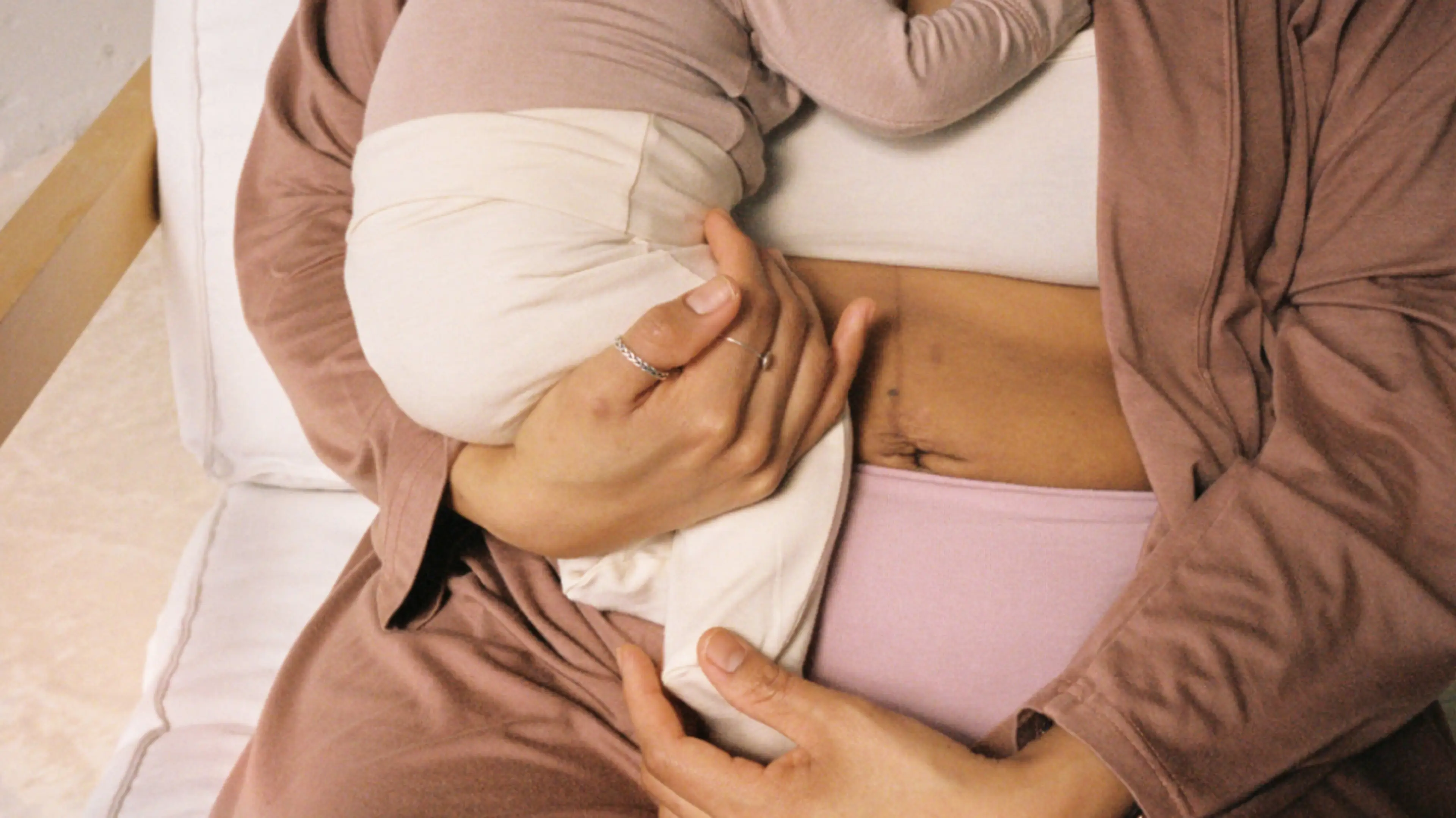It was four days after my fourth baby’s birth. I’d just settled in back home and was recovering with my snuggly newborn when I started to not feel right. I was a bit dizzy, had a headache, and could only seem to describe how I was feeling as “off.” At first, I dismissed it as typical postpartum shenanigans. But it continued. The on-call ob-gyn sent me to a pharmacy to get my blood pressure taken. It was sky high, an alarming number for someone who hasn’t seen an even slightly out of-range blood pressure result in my life. I was shocked.
The urgency on the pharmacist’s face said it all. She took it again, and again, without change. Then, she immediately sent me to the ER. I thought, “I can’t go there. I’m in the middle of establishing a breastfeeding schedule. I’m bleeding and exhausted and have a bunch of other kids to take care of.” But that’s where I found myself. I was being checked for postpartum preeclampsia, a confusing term given that I thought PREeclampsia would be during pregnancy not POSTpartum.
Luckily, my blood pressure issue resolved before they diagnosed official PP, but the scare was enough for me to raise my vigilance about the signs and symptoms during those crucial postpartum days. According to the Preeclampsia Foundation1 , the rate of preeclampsia diagnosis across all stages has increased 25% in the last two decades. Today, it is considered a leading cause of maternal death. The good news is that these increased rates have led to an increased awareness in moms who can speak up about their symptoms, and also in providers being vigilant about looking for it.
“Preeclampsia can happen during pregnancy (most often in the third trimester), while in labor, or postpartum. When preeclampsia happens in the postpartum period, it most frequently occurs in the first few days to a week after birth,” says Melissa Dennis, MD, FACOG, Chief Medical Officer at Partum Health in Chicago. I was in the prime window of concern, and hadn’t even heard of the condition before. “When a woman is experiencing preeclampsia, her blood pressure is elevated, and most commonly, although not always, she has an elevated level of protein in her urine.”
Here’s what I was so glad I knew the next time around after my fifth baby’s birth.
What Is Postpartum Preeclampsia?
The condition is so common that I absolutely should have been more educated about it with each birth. Dr. Dennis says that around 1 in 25 pregnancies result in preeclampsia, but 5% of those are diagnosed postpartum. “What’s incredible is the development of preeclampsia initiates all the way at the beginning of pregnancy when the placenta develops, but the signs and symptoms don’t show up until much later,” she adds.
Any diagnosis after such a major life event can feel alarming. But Dr. Dennis reassures postpartum mothers that it’s often very treatable. “Most women who develop postpartum preeclampsia do quite well. However, hypertensive disorders in pregnancy, including postpartum preeclampsia, are one of the leading causes of maternal deaths, so warning signs and symptoms should not be ignored.” Research2 shows the first day postpartum is most dangerous, and researchers call for enhanced frequency and quality of postpartum assessments to ensure women’s safety.
What Are the Signs and Symptoms?
Dr. Dennis says the typical signs of preeclampsia to look out for include:
nausea and vomiting
heartburn
pain or discomfort in the right upper part of the abdomen (below the ribcage)
headache
visual changes
seeing “floaters” or spots
But one of the reasons all birthing people should be aware of the possibility of postpartum preeclampsia is because the signs and symptoms aren’t always obvious, and patients may even be asymptomatic.
In an October 2023 Q&A conducted by Emily Oster3 , author and parenting data scientist, one commenter wrote about the part her lack of awareness played in her postpartum preeclampsia experience. “I will add that in my experience they don't do a great job of prepping people for this—I was not prepared for this with my first one despite having an early diagnosis of pre-eclampsia because my doctors did not tell me this was the typical postpartum course,” wrote Jeana.
What Are the Risk Factors?
Shannon Robson, a mom to a 4-year-old in Los Angeles and the Managing Editor of Babylist, Expectful’s parent company, remembers feeling “huge shock” after getting a postpartum preeclampsia diagnosis after having a complication-free pregnancy.
“I am so, so thankful I had a C-section, because it meant that I had the option of staying an additional night at the hospital covered by insurance, and that last day at the hospital was when my blood pressure spiked. I ended up staying a total of 9 nights while they monitored my every few hours, and lucky for me, that ended up being the worst of it,” Robson said. Her C-section was planned because her baby was 5 days overdue, but she wasn’t aware of any PP risk factors, aside from it being her first pregnancy.
“While postpartum preeclampsia can happen to any birthing individual, we do know there are risk factors that place patients at higher risk,” Dr. Dennis says, including a history of a variety of conditions such as:
chronic hypertension or preeclampsia
diabetes
kidney disease
certain autoimmune disorders
obesity
extremes of age in the reproductive cycle,
African American race
conceiving by In Vitro Fertilization (IVF)
delivering multiples
Robson remembers “quizzing” her doctor on why this might have happened. “Had they missed something? Was it my weight? My age? I was 37 when I delivered.” She wondered if her swollen ankles were really a bigger red flag. “She told me they didn't know for sure, but that it sometimes has to do with the amount of fluid your body hangs on to after delivery.”
What Treatment Improves Postpartum Preeclampsia?
It can be scary to head back into the hospital with symptoms, or to get a PP diagnosis if you don’t have any. But, the good news is that doctors have specific plans and treatments to help.
“The treatment for preeclampsia is twofold: bring down the patient’s blood pressure if it is severely elevated and prevent preeclampsia from worsening and becoming eclampsia, where women can have seizures,” Dr. Dennis says.
“High blood pressure medication can be given through the IV in the case of an emergency or orally for maintenance. It is not uncommon for women to go home on oral blood pressure medication for a few months, but it can usually be stopped eventually,” she adds, noting that many blood pressure medications are safe for breastfeeding and are the most common first-line medications.
But the treatment, though life-saving, isn’t without side effects, which isn’t what most new moms want more of. “To stabilize the preeclampsia itself and prevent it from becoming eclampsia, an IV infusion of magnesium will be given for 24 hours. Magnesium has some very common and unpleasant side effects, such as nausea, fatigue, and flushing. These symptoms are most common when the medication is first started and may not last the entire 24 hours.”
But What If I’m Separated From My Baby?
Some moms worry that they won’t be able to care for their babies, or that they don’t have anybody else to take them while they get help. But getting treatment is critical to safely recovering from PP, and your hospital may be willing to work with you to bring your new baby along.
For me, I seriously considered waiting it out because I couldn’t conceive of being separated from my baby after just having him. But, that option could have been dangerous, as it is for many women. Robson was able to have her husband and baby stay with her the full 9 days, but it was likely because she hadn’t already been discharged after the birth. “I had to fight for that…but the hospital staff was sympathetic.”
“While all hospitals have different policies, many do what they can to minimize the need to separate the new mom and baby. Unless advised by your provider otherwise, you can bring your baby and another support person when you go to the Emergency Department or wherever you are directed,” she says, adding to bring your pump along in case. If you need to be readmitted to the hospital, ask if you can go to a unit where the baby can stay with you. Often, this is possible as long as you have another support person who can stay to help.”
How Should You Think About Your Next Pregnancy?
Robson and others who have had the condition carry a 25% increased risk of having it in the next pregnancy, her doctor told her, which she “admits freaked her out.” It played a role in her wanting to just have one kid. Dr. Dennis explains that the general rule of thumb in medicine is “a history of anything puts you at risk for it again.”
“So yes, having a history of preeclampsia is a risk factor for preeclampsia in other pregnancies. Knowing their history and sharing it with any future providers in subsequent pregnancies is incredibly important, as a care team might take steps like prescribing a baby aspirin to help minimize the risk.”
What I learned from my near-PP ordeal was that, with such a potentially dangerous condition, it’s crucial to get checked if you have any concerns, even if you aren’t sure or are worried you’re being paranoid. Then, everyone can rest easy—or as easy as possible with a newborn.












